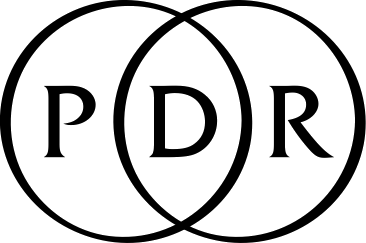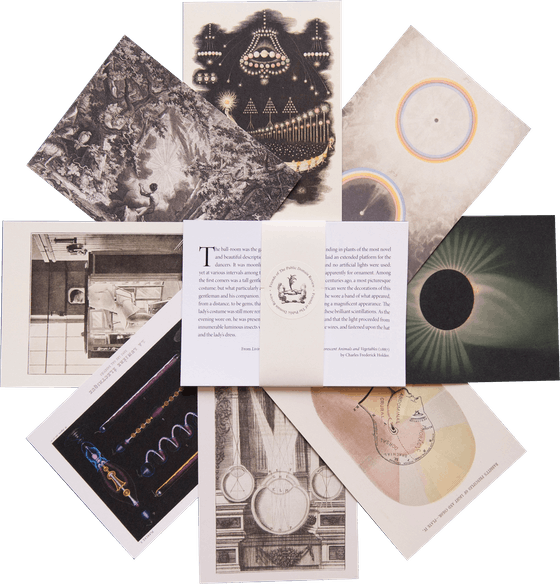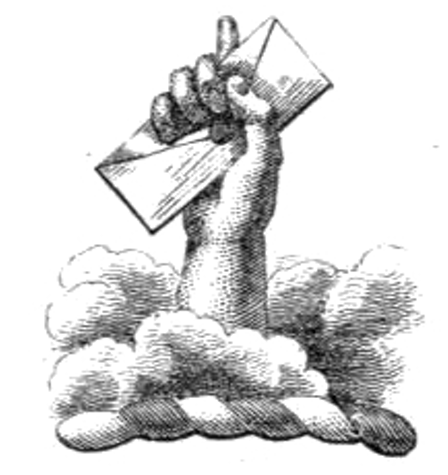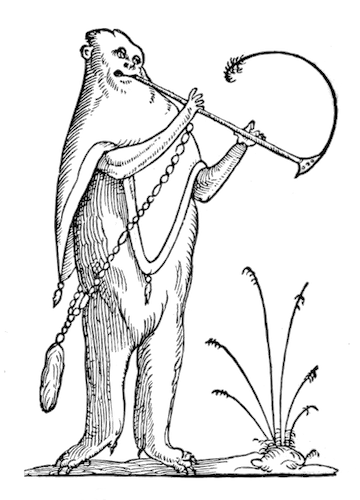
“Quaint Dessert Dishes” in American Homes and Gardens (1911)
“To the child mind”, Percy Collins wrote in American Homes and Gardens in 1911, “two bananas served upon a plate are just what they appear to be and nothing more.” Hardly an exciting dish for one’s birthday. “But” — ah! — “let the fruit be converted into a mysterious pair of porkers by the simple expedient of adding broken matches for legs, paper tails and ears, and eyes painted with Chinese white upon the yellow rinds, and it will be changed at once into an object of desire.”
Pigs are not the only things into which a humble banana can be transformed: it can serve as the body of either an Irishman or a Welsh woman, a “Red Indian’s” canoe, an elephant’s legs, or even a “booby bird’s” neck. Hazelnuts are perfect for everyone’s head (two of them make a cat, “a very weird creature”) — and if necessary, some pears can be pressed into service. Food need not just be itself. With a little bit of work it can be rearranged into a menagerie of people, animals, and even buildings. Though Collins has given us eight suggestions to get started, “it is obvious”, he promises, “that the few brief descriptions which have been given by no means exhaust the list of possible dishes.”
These quaint confections would be both dessert and entertainment at a birthday party, which was still a relatively recent invention: brought over from Germany, birthday parties only became commonplace in the United States in the 1830s, and remained an extremely formal, parent-controlled event until the 1870s. The playful glee of Collins’ creations belongs to the birthday party of the turn-of-the-century, when it began to take on its contemporary, child-led shape: “Happy Birthday to You” was composed in 1894, and the Boston Cooking School Magazine started printing birthday cake recipes (for use with candles) in 1906.
Despite his ingenuity in this matter, Collins was not a chef. He was a magazine writer, primarily producing articles about biology for Scientific American, American Homes and Gardens’ parent publication. For the latter, he often authored essays that sought to expand how his readers thought about the non-human world. In June 1907, he wrote of “The Nuptials of the Flowers”; in May 1909, of “Ants and Bees as Pets”. Most provocatively, perhaps, in September 1909, he asked, “Do Plants Think?” The elastic and under-explored possibilities of the natural world seemed to inspire his creations.
American Homes and Gardens, which became an independent publication in 1905, was part of an explosion of so-called “shelter magazines” — House Beautiful (1896); House & Garden and Country Life in America (1901); Suburban Life (1903) — that used the magazine boom of the early twentieth century to help the increasingly suburbanizing, city-fleeing middle class get their houses in order. And on a budget, too: although the February 1911 issue of American Home and Gardens in which these quaint dessert dishes appears begins with a lavishly illustrated profile of Romulus R. Colgate’s palatial 1906 Connecticut estate (recently listed for sale) for $7.5 million), the rest of the magazine is committed to moderate ambition and modest scale. Each issue explores the exciting potential of concrete, in building and decoration, at length.
Although “Quaint Dessert Dishes” is among several articles that are explicitly directed at a female reader, American Homes and Gardens’ writers and readers were mostly male. At the turn of the century, men were not only interested in but responsible for the home. If the term “home-maker” is mostly applied to women today, the historian Margaret Marsh has shown that the turn of the century saw a boom in male suburban home-making. Martha and Robert Bruère, influential Progressive economists, thus proclaimed that “When God made homemakers, male and female created He them!” And indeed, in the unsigned editorials by editor Charles Allen Munn (whose friends praised not only his good taste in art but also his “far rarer quality of the home-maker”), he made the case for male domestic involvement, writing, in December 1905, that “the responsibility for the home is not [the woman’s] alone, but is equally the husband’s.”
Perhaps Collins, too, was one of these new domestic men. Though he addresses a female reader, one likes to imagine that his article commemorates something he himself “prepared specially for the amusement of a party of youngsters”. Perhaps he, as chuffed with his creations as he suggests his reader will be, brought the pictures onto the suburban rail and into Scientific American’s New York offices, showing off to his coworkers all he’d been able to make out of a few fruits. He certainly seems to have gotten a kick out of it: “a noteworthy fact”, he writes, is “that the ‘grown-ups’ took their full share of the fun when the dishes came to the table.”
So much delight, and for such “small expenditure of time and patience”. He can’t have known how quickly the novelty would wear off: according to Elizabeth H. Pleck, as soon as the 1940s, parents were sick of the birthday party rigamarole. In May 1946, Life magazine proclaimed that “to most parents the prospect of giving a child’s party is about as appetizing as giving a lynching.” Some parents today might feel the same way — but there’s always more banana-based sculptures to try out.
Enjoyed this piece? We need your help to keep publishing.
The PDR is a non-profit project kept alive by reader donations – no ads, no paywalls, just the generosity of our community. It’s a really exciting model, but we need your help to keep it thriving. Visit our support page to become a Friend and receive our themed postcard packs. Or give a one-off donation. Already a supporter? A huge thank you for making all this possible.
“A cottage of sponge cake with icing sugar and whipped cream.”
“Bananas. The old Irishman taking his pig to market.”
“The elephant is made from a big pear and a small apple skewered together and mounted on two pieces of banana.”
“Banana pigs. The legs are are matches, while the eyes are indicated in icing sugar.”
“An old Welsh woman made out of a banana with a nut for her head. The cat is made from two nuts and some matches.”
“This old tramp is made from a banana; his fire being a few filbert nuts; his hat a blackened cork on a small circular card.”
“The Red Indian. A banana, a fig, a filbert nut, and some jelly in plate.”
“This booby bird is made from fruit, skewers, and tissue paper plumes.”
Nov 25, 2025








